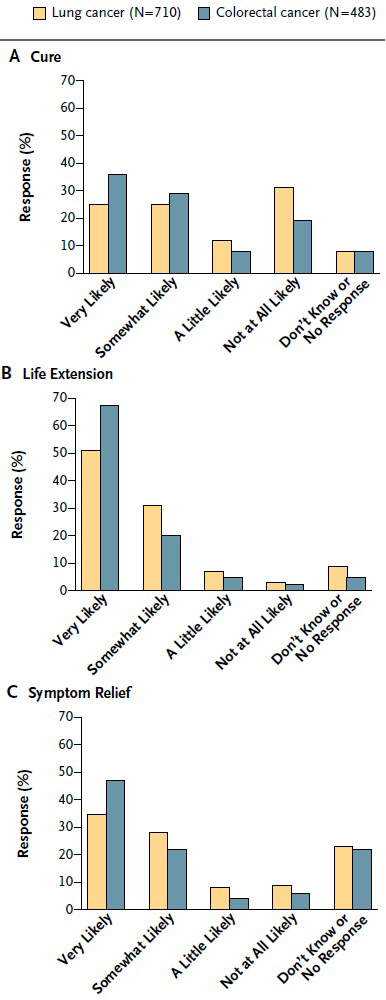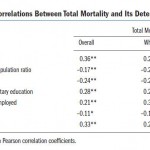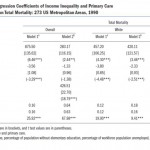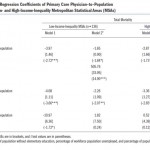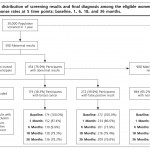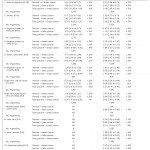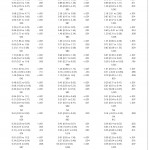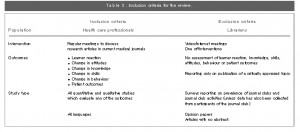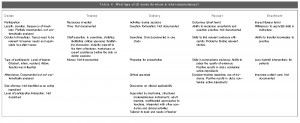– 文献名 –
Jane C. Weeks, et al.Patients’ Expectations about Effects of Chemotherapy for Advanced Cancer
N Engl J Med 2012; 367:1616-1625
– この文献を選んだ背景 –
栄町に赴任してから在宅で6名の患者さんをお看取りさせていただいた。そのうち癌で看取ったのは4人いらっしゃるが、御家族の反応としてまったく悔いなくお看取りができたと考えている家族や、民間療法を行った方が良かったのではないかと考えている家族、癌が見つかった段階でもっと治療を受けさせた方がよかったのではないかと考えている家族などそれぞれの思いがあった。
私自身は医師でありもし自分や家族が進行がんと診断された場合にとるであろう行動はイメージできるが、それぞれの家族の反応を見て改めて同じステージの癌でも患者さんやご家族が考えることは個別性のあるものであることを実感した。
そうしていたところ、このような文献を見つけたので読んでみることとした。
– 要約 –
背景:転移性肺癌あるいは転移性大腸癌は、化学療法によって生存期間が数週間から数ヶ月延長し、症状が緩和される可能性がある。ただ、癌の治癒そのものが得られるわけではない。
方法:癌治療転帰調査サーベイランスCancer Care Outcomes Research and Surveillance(CanCORS)研究(アメリカのプロスペクティブ観察コホート研究)の参加者で、癌診断後4ヶ月の時点で生存しており、新た に診断された転移性肺癌または転移性大腸癌に対して化学療法を受けた1193人を対象とした。
化学療法によって治癒する可能性があるという期待をもっている患者の割合を同定し、この期待に関連する臨床的因子、社会的因子、医療制度因子を検証した。診療録の再検討だけでなく、専門の面接者によって患者情報を得た。
結果:1193人(肺癌710人、大腸癌483人)が登録された。全体で、肺癌患者69%と大腸癌患者81%が、化学療法によって癌が治癒する可能性が全くない ことを理解しているという回答をしなかった。多変量ロジスティック回帰では、化学療法に関する誤った考えを報告するリスクは、大腸癌患者のほうが肺癌患者 よりも高く(OR1.75; 95% CI, 1.29 to 2.37)、非白人患者やヒスパニック系患者では非ヒスパニック系白人患者よりも高く(ヒスパニックOR2.82; 95% CI, 1.51 to 5.27; 黒人OR 2.93; 95% CI, 1.80 to 4.78)、医師とのコミュニケーションについてとても良好であると評価した患者では、あまり良好でないと評価した患者よりも高かった(OR for highest third vs. lowest third, 1.90; 95% CI, 1.33 to 2.72)。
社会的教育水準、身体的機能状態、意思決定における患者の役割と、化学療法に関する過度の誤認との関連はなかった。
結論:
化学療法を不治の癌に対して受けている患者の多くは、化学療法によって癌が治癒する可能性は低いことを理解していない可能性がある。ゆえに十分な情報に基 づいて、自身の意向に沿った治療を決定する能力に欠けている可能性すらある。医師は患者の理解を深めることが可能であるが、ただしこれが患者満足度の低下 という代償を伴うおそれもある。
– 考察とディスカッション –
今回の研究で進行がん患者が化学療法の限界に対して正しく認識していない可能性があることがわかった。しかし、治癒は期待できなくても予後の延長や症状緩和への期待はできることから進行がん患者の治療の選択としては有用である場合があるため、患者との決断の共有が非常に重要になると思われる。
また、医師患者関係が良い方があまり良好でないと答えた群よりも化学療法に関する誤った報告をするリスクが高いことは非常に驚いた。医師患者関係が良好であるほど患者が楽観的になる傾向があるかもしれないし、医師もシビアな情報を提供しにくいと考えてしまうかもしれないと感じた。
地域でケアを受けている患者に誤解が少なかったとの結果もあり、他職種と連携しながら患者のアプローチをするなど地域特有の距離感などが有用であるかもしれないと感じた。患者との関係性を維持しながら終末期の患者に対して適切な時期に効果的な終末期ケアを導入できるように努力する必要があると感じた。
開催日:平成25年8月14日
